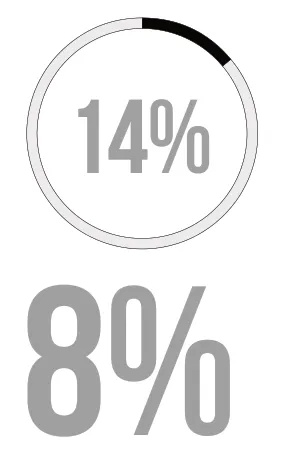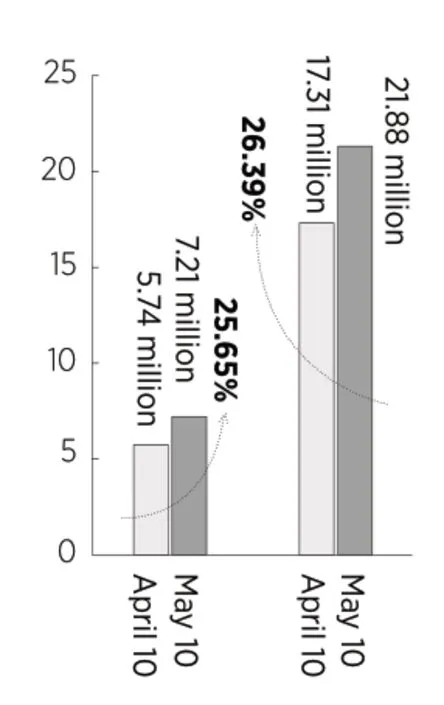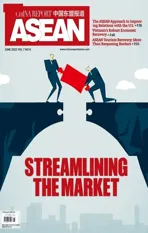Breaking The Block
2022-06-23ByXiaoXin
By Xiao Xin

After being stranded for days due to epidemic control,trucks queue up to exit the Shenyang-Haikou Highway (G15) in Nantong,Jiangsu Province,on April 15,2022.(VISUAL.PEOPLE.CN)
Throughout April as China was involved in an all-out effort to contain Omicron in the financial hub of Shanghai,one of the area’s greatest advantages—a smooth and fast transportation and logistics network—partially devolved into a pain point hindering economic activity.
The Chinese saying“wherever there’s pain,there’s a blockage”certainly applies to the numerous road transport blockages,most notably in the Yangtze River Delta region centered around Shanghai.
The government’s swift move to troubleshoot the malfunctioning logistics network coincided with the national push for building a unified domestic market,and such sharp acute pain likely serves to warn of more fundamental economic problems that more people should be concerned about.
Road Travails
With the nation poised to fight Omicron spread in Shanghai,sporadic roadblocks seemed to toss cold water on zealous efforts to deliver food,medical,and other key supplies to the virus-ravaged city.
When the caseload surged in Shanghai in April,many local governments introduced independent viral prevention and containment measures including the suspension of intercity highway services seeking to curb Omicron spread.
Nationwide,678 toll stations were suspended due to the virus resurgence by April 10 while 364 service areas were closed,official data showed.
The blockage appeared to be compounded by tighter restrictions that were at local government discretion,eroding the country’s road transport capacity,a foundation of the economy.
“In 2020,all 17.28 million truck drivers in the country handled 74 percent of freight traffic,a significant contribution for economic and social development that ensured and improved people’s livelihoods,”said Wang Yang,then vice minister of transport,at a Beijing press conference in November 2021.
Multiple reports emerged of truck drivers bewildered by varied regionally specific passes and quarantine requirements that varied significantly based on each route.
A truck driver named Gao Chen from east China’s Anhui Province came to represent the arduous physical and psychological journey cargo freight makes to support economic operations amid wide-ranging virus containment efforts.The triangle-shaped region with Shanghai at its heart covers the provinces of Anhui,Jiangsu,and Zhejiang.
Gao and his wife are a typical duo employed as long-haul truckers,as depicted in an article from Southern Metropolis Daily in mid-April.
With a purchased truck,the couple spends about 12 hours a day traveling between the Yangtze River Delta and the Pearl River Delta.They usually make four round trips every month.
The recent outbreak of Omicron prompted many regions to respond with an array of preparedness and prevention measures.Expressways that normally provided unhindered flow of traffic slowed into a maze of checkpoints.
On April 6,Gao picked up a shipment from Nantong in east China’s Jiangsu Province bound for Zhuhai in south China’s Guangdong Province,which necessitated a special pass from local authorities at township level in Nantong.
The next day,Gao took antigen and nucleic acid tests at an expressway rest area entrance and waited around for nearly three hours before passing.He was not allowed to leave the cabin until the cargo was fully loaded onto his truck.
Such sharp acute pain likely serves to warn of more fundamental economic problems that more people should be concerned about.
When Gao approached the destination in Zhuhai,those inspectors refused to recognize the nucleic acid test he took the night before in Jiangxi Province.Because proof of a local negative COVID-19 test within 24 hours is mandatory,he had no choice but to park the truck near the destination and spend another night seeking local results.
And in certain cities,cargo that wasn’t categorized as key anti-virus supplies was delayed,resulting in truck drivers waiting up to eight days on the expressways,according to media reports.
The worst-case scenario for truck drivers is a travel code marked with an asterisk,which means that the cities they have visited in the past 14 days are medium or high-risk areas,blocking their access to most places.They are either persuaded to return to where they came from or pay for quarantine at a designated place.
Such travails seem like a totally different virus variant.But a sober assessment shows more fundamental concerns:a rather fragmented road transport network that could be problematic in urgent emergency situations.
Incompatibility
Disrupted logistics has been in essence attributed to closedloop quarantine standards widely accepted in the logistics industry that are not compatible with region-varying closed-loop quarantine policies,according to Lu Chengyun at the National Development and Reform Commission (NDRC)’s Institute of Comprehensive Transportation,as quoted by the Beijing News in mid-April.
Such incompatibility points to a broader issue with the country’s transportation and logistics.
The predicament in the logistics industry during the epidemic highlights that excessive costs of communication and coordination between different regions and various government bodies are an important impeding factor,reported the China News Service in mid-April,citing Cai Zhibing,associate professor at the Party School of the Central Committee of the Communist Party of China (CPC).
The logistics industry is essentially about economic bonds between different parts of the country.The closer the regional economic relationship,the cheaper the flows between the regions should be,and the more prosperous the logistic sector can become,Cai said.
China’s logistics spending accounts for over 14 percent of GDP,considerably higher than around 8 percent in developed nations,he noted,anticipating that a unified domestic market would effectively lower logistics costs.
A survey of the country’s expressway enormity,nonetheless,offers some clues as to why discrepancy often prevails over consistency.
With a total length of around 160,000 kilometers,China’s expressway network is the world’s largest.This feat could be easily taken for granted,given the size of the economy and its strong infrastructure push over the decades.
But the feat was accomplished through incremental prowess,with local governments primarily relied on to fund the expressway network.
Under the country’s fiscal and tax system,a gap remains between local governments’autonomy in carrying out their fiscal functions and their responsibility to accelerate local economic development.
To enable transport connectivity,local governments’financing vehicles and large centrally administered stateowned construction firms are known as the mainstay of fundraising for highways.

A medical worker takes a sample for a COVID-19 nucleic acid test from a driver at a highway exit in Jiaozuo,Henan Province,on March 19,2022.(VISUAL.PEOPLE.CN)

Traffic police direct trucks to leave the Huainan Exit of Hefei-Huainan-Fuyang Expressway on May 7,2022.(VISUAL.PEOPLE.CN)
Strengthening highway maintenance and management means continued commitment after highways open to traffic,which seems to have only expanded local governments’role in highway-related policymaking.
Currently,more than 20 highway-related listed firms are in the Chinese mainland stock market,and most are actually controlled by local governments whose core assets are their right to collect tolls for travel across premium highways and bridges and to operate expressways and bridges.
As the country’s highway network matures,with added lineage stabilizing,some of the earliest completed highways have reached or are set to hit expiration for toll payments.
This suggests expressway operators ought to diversify into other sectors to continue expanding.Accordingly,multiple service areas in Jiangsu have been remodeled as shopping centers and tourist attractions as part of an industry-wide push to carve out a path toward highway profitability.
The regionally segmented landscape of highway building and maintenance and the resulting highway-related decision-making demonstrate the need for a top-down approach to dissolve clots impeding transport arteries.
Fundamental Cure?
Coincidently,the guidelines for accelerating the building of a unified domestic market were unveiled by the CPC Central Committee and the State Council on April 10.The toplevel strategy intending to break local protection and market fragmentation also covered logistics concerns.
Specifically,the strategy urged construction of an emergency logistics system and crossregional integration of transport infrastructure.
Soon thereafter on April 11,the State Council,the country’s cabinet,issued a notice requesting local governments to“make every effort”to address road network blockages and congestion and ensure smooth main arterial roads.
Any blockages or shutdowns of highways,roads and waterways,without authorization,would be strictly prohibited,read the notice.Unauthorized closures of highway rest areas,port terminals,railway stations,and airports and unapproved bans on crew shift changes for international shipping services were not allowed as well.

Nationwide,678 toll stationswere suspended due to the virus resurgence by April 10 while364 service areaswere closed,official data showed.

China’s logistics spending accounts for over14 percentof GDP,considerably higher than around8 percentin developed nations.

On May 10,national roads hit a traffic volume of21.88 millionvehicles,an increase of26.39 percentfrom April 10.Truck traffic totaled7.21 millionvehicles,up25.65 percentfrom the April 10 reading.
The quick removal of roadblocks,representative of the change-as-you-go toughening of restrictions in the domestic market,evidently offered clues on dealing with market fragmentation.
A suspension in case of confirmed infections or close contacts will need to be reported to the provincial-level joint epidemic prevention and control mechanism for approval.A shutdown of airports that involves cross-provincial or international flights will have to be filed with the State Council or departments under the cabinet for approval,the notice stipulates.
Showing commitment to a problem-oriented approach,the State Council notice mapped out targeted traffic management that wouldn’t restrict flow of freight vehicles or passengers.Vehicle registration and household registration were prohibited as restraints to limit traffic.And truck drivers,passengers,and crews with a green health code cannot be stopped just for an asterisk.
Shortly after the notice,the State Council’s joint epidemic prevention and control mechanism released the national standardized pass.With the pass,freight vehicles passing through virus-hit regions across provinces would gain priority access.Eligible regions were required to create fast lanes dedicated to vehicles holding the pass.
The timely notice and a slew of efforts in its wake,primarily headed by the Ministry of Transport (MOT) and NDRC,quickly dissolved the transport clots.
By April 26,only eight toll stations remained out of service,accounting for 0.07 percent of the nation’s total.Meanwhile,27 service areas,or 0.41 percent of the country’s total,were still suspended,as per transport ministry statistics.
At a May 11 media briefing,a month after the worst of the roadblock predicament,Li Guoping,security director at MOT,announced that“the number of out-of-service toll stations and service areas has basically been reduced to zero.”
As the toll stations and service areas get back up and running,logistics are improving.
On May 10,national roads hit a traffic volume of 21.88 million vehicles,an increase of 26.39 percent from April 10.Truck traffic totaled 7.21 million vehicles,up 25.65 percent from the April 10 reading,according to Li.
The quick removal of roadblocks,representative of the change-as-you-go toughening of restrictions in the domestic market,evidently offered clues on dealing with market fragmentation.
As Cai put it,availability of unified industry regulations should be a prerequisite for reducing the costs of communication and coordination across different parts of the country to foster a stable and healthy logistics industry.
The remaining question is whether current policy is merely a stopgap band-aid or a fundamental cure that could be referenced to diagnose and treat other pain points haunting China’s huge market.
